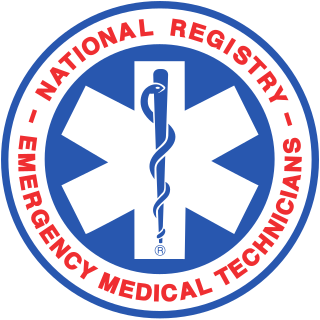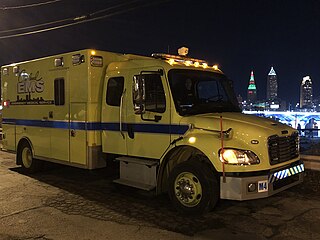
Wrightsville is a borough in York County, Pennsylvania, United States. The population was 2,257 at the time of the 2020 census. It is part of the York–Hanover metropolitan area.

A fire department or fire brigade, also known as a fire company, fire authority, fire district, fire and rescue, or fire service in some areas, is an organization that provides fire prevention and fire suppression services as well as other rescue services.
The Seattle & King County Emergency Medical Services System is a fire-based two-tier response system providing prehospital basic and advanced life support services.

The Chicago Fire Department (CFD) provides firefighting services along with emergency medical response services, hazardous materials mitigation services, and technical rescue response services in the city of Chicago, Illinois, United States, under the jurisdiction of the Mayor of Chicago. The Chicago Fire Department is the second-largest municipal fire department in the United States after the New York City Fire Department (FDNY). It is also one of the oldest major organized fire departments in the nation. It has numerous general purpose and specialized vehicles and equipment to accomplish its missions.

The Los Angeles County Fire Department (LACoFD) provides firefighting and emergency medical services for the unincorporated parts of Los Angeles County, California, as well as 59 cities through contracting, including the city of La Habra, which is located in Orange County and is the first city outside of Los Angeles County to contract with LACoFD.

In the United States, the paramedic is a allied health professional whose primary focus is to provide advanced emergency medical care for patients who access Emergency Medical Services (EMS). This individual possesses the complex knowledge and skills necessary to provide patient care and transportation. Paramedics function as part of a comprehensive EMS response under physician medical direction. Paramedics often serve in a prehospital role, responding to Public safety answering point (9-1-1) calls in an ambulance. The paramedic serves as the initial entry point into the health care system. A standard requirement for state licensure involves successful completion of a nationally accredited Paramedic program at the certificate or associate degree level.

The Montgomery County Fire and Rescue Service (MCFRS), officially the Montgomery County Department of Fire and Rescue Services (DFRS), is the public safety agency that provides fire protection and emergency medical services for Montgomery County, Maryland. The services are provided by a combination of paid county personnel and volunteer members of the various independent, non-profit volunteer fire and rescue corporations located throughout the county.
Winnipeg Fire Paramedic Service (WFPS) provides fire and EMS services to the City of Winnipeg, Manitoba. It operates from 27 fire stations, and 3 administration offices across the city.

The Detroit Fire Department (DFD) provides fire protection and emergency medical services to the U.S. city of Detroit, Michigan.

The National Registry of Emergency Medical Technicians is a US certification agency covering prehospital medical providers.
The Indianapolis Fire Department (IFD) provides fire and rescue protection and emergency medical services to the city of Indianapolis, Indiana. In total the department serves 278 square miles (720 km2).

The Prince George's County Fire/EMS Department (PGFD) is a combination career/volunteer county-level agency that provides "..fire prevention, fire protection, emergency medical services, rescue services and community outreach programs" for residents of Prince George's County, Maryland. The department is composed of volunteers from 33 fire companies throughout the county, that are represented by the Prince George's County Volunteer Fire & Rescue Association, as well as career firefighters affiliated with the Prince George's County Professional Firefighters and Paramedics Association, IAFF Local 1619. According to the Firehouse Magazine 2010 Combination Fire Department Run Survey, the Prince George's County Fire/EMS Department covers a response area of approximately 580 miles, protects approximately 900,000 people, and has an annual operating budget of $132 million. Prince George's County Fire/EMS Department responded to 148,506 calls in 2016 according to the 2016 National Run Survey. 29,702 of those calls were fire related and 118,804 that were EMS calls, making Prince George's County Fire/EMS Department the busiest combination fire department in the United States to submit statistics.

Firefighting in the United States dates back to the earliest European colonies in the Americas. Early firefighters were simply community members who would respond to neighborhood fires with buckets. The first dedicated volunteer fire brigade was established in 1736 in Philadelphia. These volunteer companies were often paid by insurance companies in return for protecting their clients.
Jullette M. Saussy is a medical doctor and the former head of emergency medical services for New Orleans, Louisiana, and Washington, D.C.
The New Haven Fire Department (NHFD) provides fire protection and emergency medical services to the city of New Haven, Connecticut. The New Haven Fire Department currently serves a population of over 130,000 people living in 19 square miles of land and is one of the largest fire departments in the state.

Kenneth B. Ellerbe was an American firefighter who served as the fire chief of the District of Columbia Fire & EMS Department from January 1, 2011 to July 2, 2014. He was chosen by mayor-elect Vincent C. Gray in December 2010.
The history of the District of Columbia Fire and Emergency Medical Services Department, which grew gradually as volunteer companies formed between 1770 and 1860, then more rapidly with the addition of paid members starting in 1864 and the transition to a fully paid department in 1871, has been marked in recent years by various controversies and scandals.

The Vancouver Fire Department (VFD) provides fire protection and emergency medical services to the city of Vancouver and, by contract to Clark County Fire District 5, in Washington, United States. The VFD's response area is 91 square miles (240 km2) with a population of over 294,000 (2023). The VFD has the highest call volume per firefighter in the state. ALS transport is provided by AMR, making the VFD's service area population by far the largest in Western Washington without public ALS ambulance service.
LaRuby Zinea May is an American politician and African American lawyer who formerly represented Ward 8 on the Council of the District of Columbia in Washington, D.C. She won the Ward 8 special election on May 10, 2015, succeeding Marion Barry, who died in office on November 23, 2014. May, who was sworn into office on May 14, 2015, served out the remainder of Barry's term, which ended on December 31, 2016. During her first council term, she was active on the issues of crime and violence, marijuana policy, assisted suicide, and improvements to Advisory Neighborhood Commissions. She criticized the city's emergency medical services department, opposed the creation of a public electrical utility, and applauded the construction of a sports arena in her ward. She was one of the few council members to support the mayor during the FreshPAC scandal, and although she asked Congress to end its school voucher program she also supported a political action committee which supports an expanded voucher and charter school program in the District. She is a member of the Democratic Party.

The City of Cleveland Division of Emergency Medical Service, also known as Cleveland EMS or CEMS, is the division of the municipal government tasked with emergency ambulance transport for the City of Cleveland, Ohio.



















